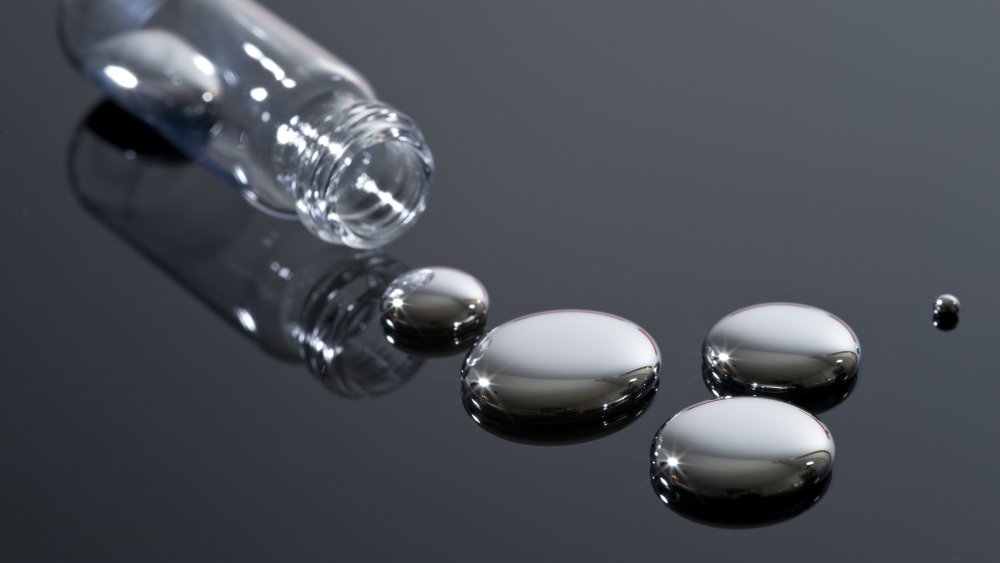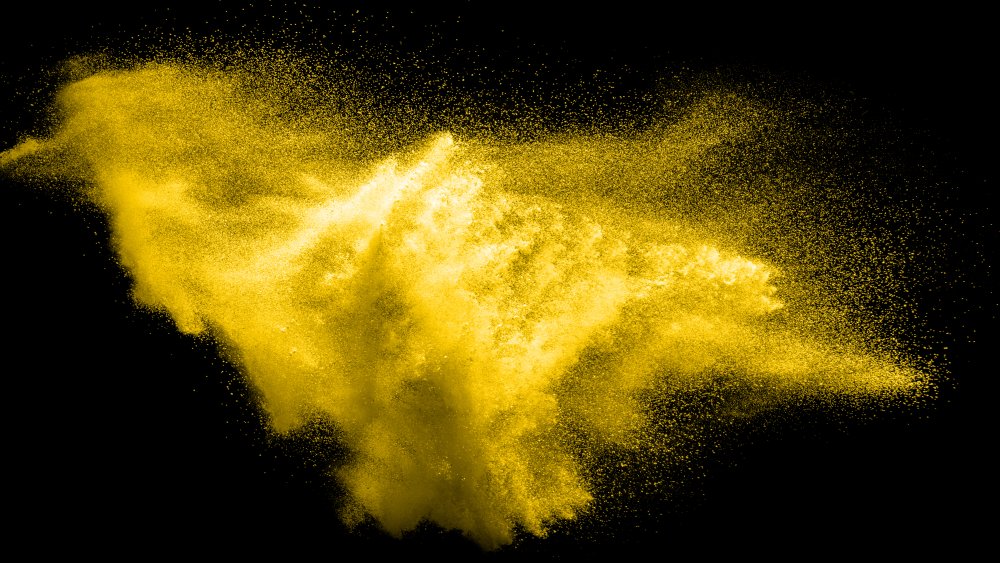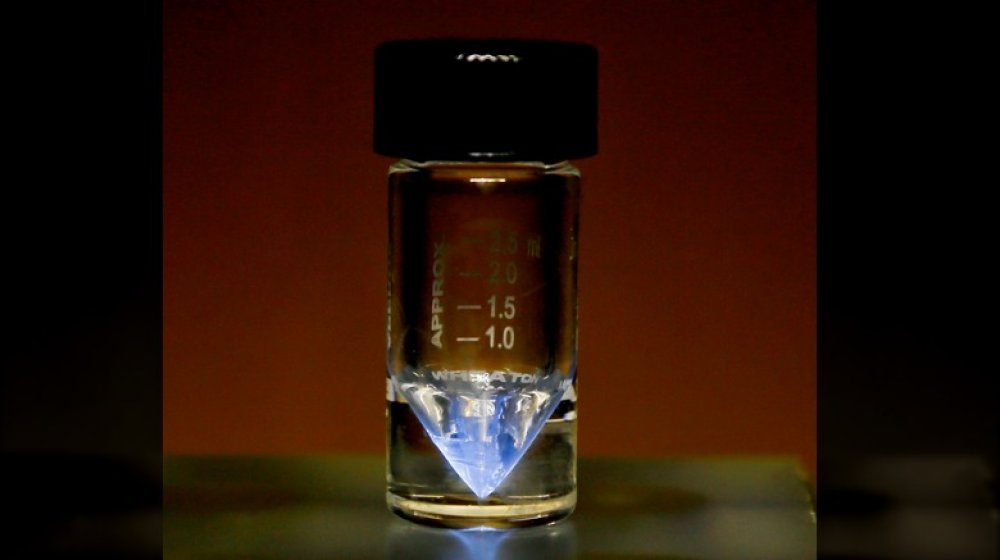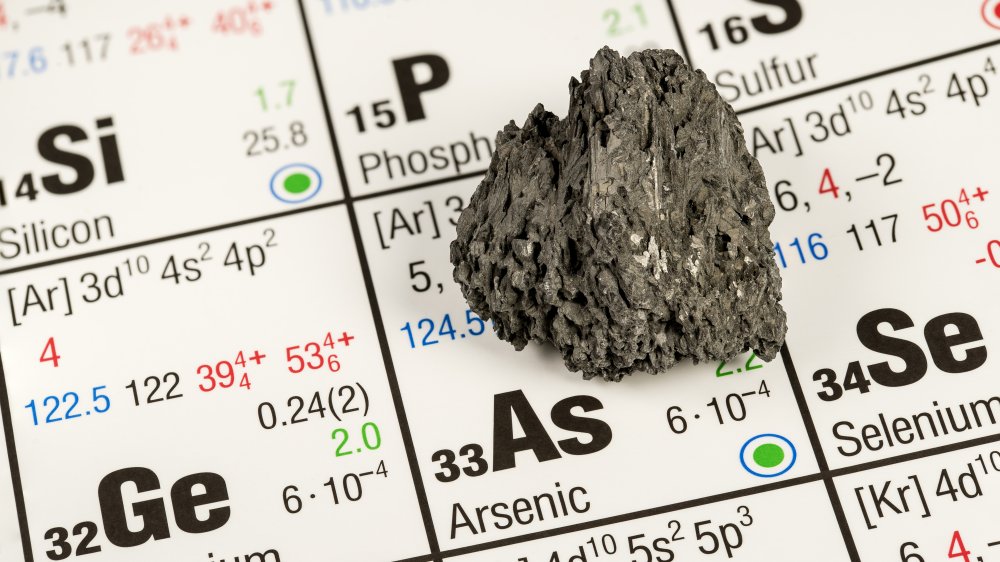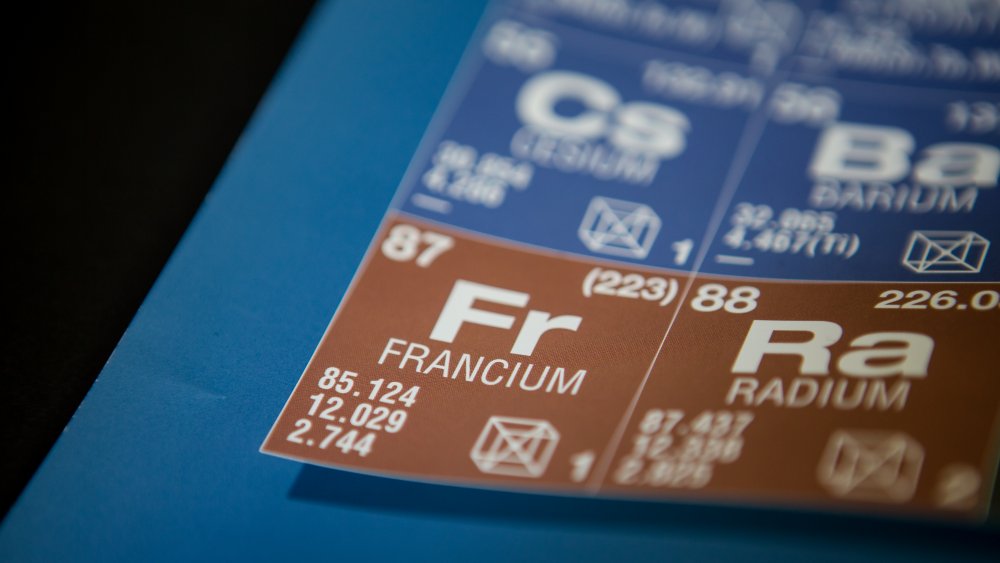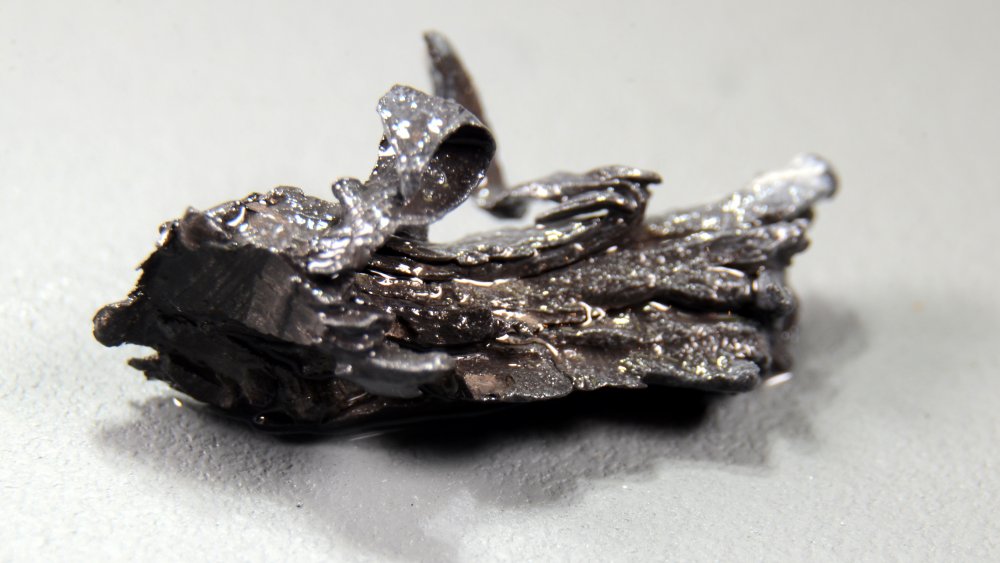The Most Dangerous Elements On Earth
So here's a question: what makes an element, well, an element? Sure, they're the things on the periodic table and all, but according to Chemistry World, it's pretty tricky defining just what makes an element. The Ancient Greeks, after all, thought there were just four elements — air, earth, fire, and water. To keep things simple, let's take the definition of the 17th century chemist Robert Boyle: elements are substances that can't be broken down into smaller and different components.
There. See? Science made easy.
Elements are the building blocks of the world around us, and while some have been created in a lab, many occur naturally. It's kind of weird... especially when you consider just how dangerous some of these elements are. There's many we need to survive — like oxygen — but there's quite a few that will just kill us in horrible, awful, terrible, no-good ways if we even look at them funny. They're toxic, radioactive, explosive, reactive, and volatile, and the next time someone equates "all-natural" with "healthy?" Mention one of these bad boys.
Number 94: Plutonium — The heart of the world's deadliest weapons
Plutonium is at the heart of one of the most devastating weapons the world has ever seen — thousands were killed when the atomic bombs were dropped on Hiroshima and Nagasaki during World War II. Plutonium, says the Centers for Disease Control and Prevention, is a silvery metal that turns yellow when it touches the air. It also emits alpha particles, which means it's easily inhaled: particles lodge in the lungs, enter the bloodstream, circulate through the entire body, and do some truly horrible things. Sadly, Los Alamos physicists Harry Daghlian and Louis Slotin found out firsthand just how deadly plutonium is.
When the US was building the bombs that were eventually dropped on Japan, they weren't sure just how many it was going to take to get a surrender. There was a third "heart" built, ready and waiting to go into another Fat Man-style housing. It was nicknamed the demon core (pictured is a replica), and in August of 1945 Daghlian was conducting some experiments (Science Alert says they called it "tickling the dragon's tail") when he accidentally dropped a brick on the sphere. The reaction was instant: supercriticality, and a lethal dose of radiation. He was dead just 25 days later.
A year later, Slotin was conducting a similar experiment when he dropped a screwdriver. Again: supercriticality, a blue flash, and a lethal dose of radiation. A press release described what was happening to him as a "three-dimensional sunburn," and he was dead in nine days.
Number 55: Cesium — Spontaneous combustion in action
Cesium is very pretty. In its inert form, it's a series of delicate structures that look a little like a snowflake under a microscope. It's also a metallic gold color, so that's neat — and, in fact, Popular Mechanics says it's more expensive than gold. There's only a certain kind of person that would make a wedding ring out of it, though, because cesium reacts with basically everything. Leave a sample of cesium exposed to plain old air, and it'll spontaneously combust into pink and purple chemical flames. Drop it into water, and it'll explode — even if it's subjected to temperatures down to -177 degrees Fahrenheit. Cool?
Oh, and it's pretty deadly even if it's in a fairly stable isotope. In 1987, a few enterprising thieves stole a glowing stone from a discarded machine once used to treat cancer patients at the Goiania Institute of Radiotherapy in Brazil. Within days, people around the junkyard started getting sick, and were quickly diagnosed with acute radiation poisoning. Four died, 100,000 required monitoring, scores were hospitalized, and 40 homes were so radioactive, they needed to be demolished (via History). There's an important lesson in there for everyone.
So, is there a point to this stuff? There is. In 1967, cesium's emission spectrum was used to set the definition for a second of time, and the length of a meter. It's still used today in some of the world's atomic clocks, and they're so accurate they only lose one second every 100 million years.
Number 80: Mercury — Mad as a hatter
Mercury is weird stuff. Say you have an old thermometer in your house, and it's filled with mercury. If you break it, it's probably not going to make you sick... as long as you clean it up quickly and carefully, says the NHS.
But there's a major catch, according to DW. Mercury turns into a vapor at room temperature, and it's incredibly easy to breathe those vapors in: they're invisible, have no smell, and they're soluble in both oil and fat. What does that mean? When mercury is inhaled, it absorbs very easy and very quickly into the human body, passing into the lungs, blood, and finally, the brain. Symptoms include things like agitation, paralysis, sleep disorders, and strangely, a change in handwriting: victims of mercury poisoning can't write in a straight line, or stop at the end of a line.
Now, here's where you start to feel fortunate we know things like this today. The phrase "mad as a hatter" didn't actually come from Alice's Adventures in Wonderland, it was common parlance before that. It goes all the way back to the 18th century, when things like workplace safety hadn't been invented yet and mercury poisoning was common among hat-makers. At the time, hats were often made from the skins of small animals, which were turned into felt with the help of mercury nitrate. Exposure led to things like hallucinations, difficulty controlling emotions, and speech impairments, says History.
Number 88: Radium — A deadly glow
According to LiveScience, radium was discovered by Marie and Pierre Curie in 1898, and it was named for the Latin word for "ray," because they knew early on that it gave off radiation about three million times higher than what was given off by uranium... they just didn't know how bad that was.
It typically enters the body when it's inhaled or swallowed, and it causes all kinds of horrible things. Most of those things only show up in the long-term, so for a while, the world loved it and its glow-in-the-dark properties, especially for practical uses like illuminating watch dials. Only radiation on that scale is incredibly deadly. Take the tale of the Radium Girls, the watch dial painters who twirled their brushes to a point between their lips, and loved the way it made their mouths and skin glow. Some wasted away from cancers, others simply rotted where they lay.
It was believed — albeit, briefly — that radium had curative properties. It was put into everything from toothpaste to health drinks, and one of those products was Radithor, a radium-infused water promoted by an industrialist named Eben Byers (via Medium). Over a 5-year period, he drank around 1,400 two-ounce bottles, and when he was interviewed at his home for an FTC hearing investigating the drink, the attorney who met with him was shocked: his chin and lower jaw were gone, his upper jaw was protruding bone and two teeth, and holes in his skull exposed his brain.
Number 9: Fluorine — So, this is what Hell's atmosphere is made of
According to the Los Alamos National Laboratory, it took chemists 74 years to isolate fluorine... and it's no wonder. Given the number of people who were poisoned, blinded, or killed along the way, it's surprising that they just didn't give up. It exists as a highly corrosive gas, and it's one of the most reactive elements on the periodic table. And it doesn't just react — it reacts insanely: if there's fluorine gas present, you can burn water, metal, and glass (although we absolutely do not recommend it).
Lateral Science says that the problem with isolating fluorine wasn't necessarily producing it — early chemists could do that — they just couldn't contain it. Any attempts to seal it in a vessel promptly resulted in an explosion, and the list of injuries is long: Humphrey Davy was poisoned, George and Thomas Knox were also poisoned, and one was bedridden for three years afterwards. P. Louyet and Jerome Nickels both died, and well, you get the idea.
What's the point of fluorine, you ask? Chemicool says that yes, it's part of the compound sodium fluoride (the stuff in the drinking water that keeps your teeth healthy), and CFCs — olde timey refrigerant for air conditioning units. It's also used in rocket fuel and in the manufacture of uranium, so there's that.
Number 89: Actinium — Changing you on a genetic level
In 1899, Marie Curie's assistant, Andre-Louis Debierne, separated a new substance from pitchblende. He named it after the Greek word for "ray" (as opposed to radium, which was from the Latin), because — you guessed it — it's extremely radioactive. It's so radioactive, in fact that The Guardian calls it "incompatible with life." It does, however, have a lovely blue glow, but that's just the element's extreme radioactivity ionizing the air around it, so don't let it fool you.
According to Lenntech, actinium is up there with plutonium as far as radioactivity goes, and they say that even in low doses it can cause major damage to a person on a genetic level. If that exposure continues, the damage is cumulative. It's linked with leukemia, various cancers, deformities, and stillbirths, and they note several times that this is just the smallest amounts of the stuff — particularly actinium-227.
There is the chance this element might redeem itself, though: in 2018, Department of Energy researchers reported some serious success in treating late-stage prostate cancer patients with actinium-225.
Number 82: Lead — The silent killer in your own home
According to the Environmental Protection Agency, it started with the ancient world, which called lead "the father of all metals." Over the following years, it was used in makeup and paints, as birth control, as a preservative for food and wine, in condiments, and — of course — it was used for all kinds of everyday household goods. In Ancient Rome, it was so easy to source, it was the perfect metal for all their plumbing.
And here's where things get weird: they absolutely knew it could make you sick. Not only did they know, but those who worked with lead most often — the smiths — worshiped the god Vulcan, who was often depicted as having some of the most noticeable symptoms of lead poisoning: lameness and a pale complexion. But they didn't really care and today, historians are pretty sure lead poisoning helped speed up the downfall of the entire civilization. Sounds unlikely? Lead was a huge deal — take Domitian. He drank his lead-adulterated wine from a special lead fountain, after munching on his lead-seasoned food.
Considering that lead poisoning happens when lead is ingested, that's about as close to a smoking gun as history ever gets. The list of symptoms is long: Healthline says it includes everything from abdominal pain and cramps to memory loss, aggression, and irritability. When children are exposed, you can expect to add growth delays, low IQ, and behavioral problems onto that. The damage it does is irreversible.
Number 84: Polonium — Hey, at least it's rare!
The element "polonium" should ring at least some faint bells: in 2006, the one-time Russian spy Alexander Litvinenko was assassinated with it. The fatal dose was slipped into his tea, says Medical News Today. Yet that was enough polonium to warrant the closure of a handful of London establishments, and it had the potential to expose around 700 others to dangerous levels of radiation (although no one else got sick). Litvinenko was so radioactive that his autopsy required extensive safety measures, and here's something to put polonium in perspective: it's between 250 billion and one trillion times more toxic than hydrogen cyanide, and a single gram of polonium-210 could, in theory, kill 50 million people and make another 50 million sick. Give or take.
Litninenko ingested just one millionth of that, and here's the weird thing — as deadly as it can be, it's not usually dangerous. What's that mean? The radiation it gives off can be blocked by a piece of paper, it can't go through skin, and it doesn't travel more than a few centimetres through the air.
Weird, right? First isolated in 1898 by Marie Curie, it's thought to have been regularly produced in just one facility southeast of Moscow. According to The Conversation, it is kind of useful in anti-static devices, but get it into your bloodstream, and multiple organ failure is inevitable.
Number 33: Arsenic — It's not just a poison-of-choice anymore
Mankind has known about arsenic for a long, long time — and, we've also known it's great for killing people. Arsenic's toxic properties were described as far back as 370 BC, and it was famously used by Nero to kill his stepbrother and secure his place as the emperor of Rome. Sounds harsh, but arsenic's history is full of little tidbits like that. During the Renaissance, poisoners using arsenic conducted business that, at a glance, sounds fairly reputable: they took appointments, wrote up contracts, and set prices that were paid once the victim was dead.
Strangely, it was also used as a medicine: the 16th century physician Paracelsus prescribed a preparation of arsenic in the treatment of skin conditions and surface wounds. And it hung around — arsenic was still being prescribed well into the 20th century, says the Journal of Military and Veterans' Health.
In addition to being a poison, Healthline notes that arsenic is also a carcinogen. And here's the thing: it causes some weird symptoms. In addition to the usual vomiting and abdominal pain, it also causes a tingling in the extremities, the development of warts of skin lesions, red or swollen skin, and — in the case of chronic exposure, darkening skin and a sore throat that just won't go away. There's no real treatment save getting rid of the source of arsenic, and recovery — if it happens — can take months.
Number 87: Francium — Boom!
When you're looking at reactive elements on the periodic table, one of the most violent is francium. But... it's kind of hard to tell.
According to ThoughtCo., we're not entirely sure just what francium is capable of, because there's only ever been very, very small quantities produced. But that might actually be a good thing, because it doesn't just react, it reacts by exploding.
Francium explosions are also pretty hypothetical, and we can start trying to figure out what would happen if we, say, dropped even a small piece into some water. (On the off chance you find some, do not do this.) At the opposite end of the reactivity scale we have lithium: if you put a little bit of that in water, it'll float. You can also set it on fire, and it'll burn. That's cute. Sodium burns a little more, and so does potassium. Francium is on the upper end of that scale, and scientists say that tossing a piece of francium in water, well, it'd be really dumb. It would probably explode, it would definitely create a lot of hydrogen gas, a lot of heat, some francium hydroxide, and a lot of radioactivity. Exactly how much? Well, let's hope we never actually find out.
Number 81: Thallium — Another pretty perfect poison
Humans learned about thallium in 1861, and almost immediately, we learned it was pretty deadly. It's also odorless, tasteless, and given the fact that effects are very delayed, that makes it hard to determine exactly where and when a victim was poisoned. And symptoms are pretty generic: mild to low doses will cause things like nausea and vomiting, and the person might even recover... briefly. By the time they start feeling the pain from the nerve damage, it's already been done.
That, says Compound Interest, made it a favorite poison... that, and the fact that it was super accessible for a long time. It was used in a ton of different insecticides and rat poisons, meaning an enterprising young murderer could get their hands on some simply by going to the local garden store... up until the 1970s, that is. But that doesn't mean it still isn't used: in 2013, a chemist named Tianle Li was found guilty of killing her husband with the help of a few vials of thallium stolen from her lab at Bristol-Myers Squibb (via Chemistry World).
The only real antidote for thallium poisoning is a compound called Prussian blue, but given that's also poisonous, well, it's not an ideal situation.
Number 38: Strontium — It's all around us
Strontium is a little different. First, it's incredibly common — it's the 15th most common element in the earth's crust, says LiveScience. But it's also highly reactive — when it comes into contact with air, it burns. (That's why the strontium in the photo is covered with oil, to prevent it from reacting with the air.) If it's exposed to water, it'll combine to produce a powerful irritant. And synthetic strontium? That's one of the components of nuclear fallout, so you just know it's bad.
And here's the thing — it's dangerous for another reason, and that's because people are eating it. According to American Bone Health, strontium has a chemical structure that's very similar to calcium. In seemingly even better news, our bones absorb strontium and use it in exactly the same way they absorb and use calcium... so, that's a win, right?
Not exactly. After a few years of pretty regular, widespread use of the compound strontium ranelate, it was found ingesting strontium had a whole list of nasty, potentially deadly side effects, like heart attacks, blood clots, pulmonary embolism, seizures, reduced red blood cell counts, and liver inflammation. Oh, and it was also found to interfere with some individuals' ability to think. According to Lenntech, other strontium compounds — like strontium chromate — are also a danger, but they add that radioactive strontium is much, much more dangerous than the stable version... kind of like, you know, pretty much everything.



